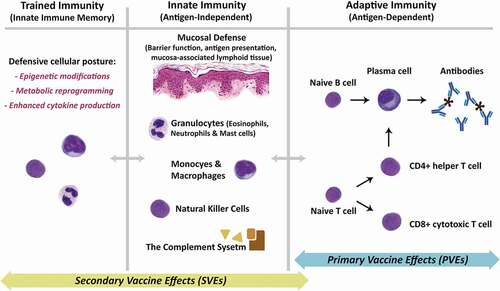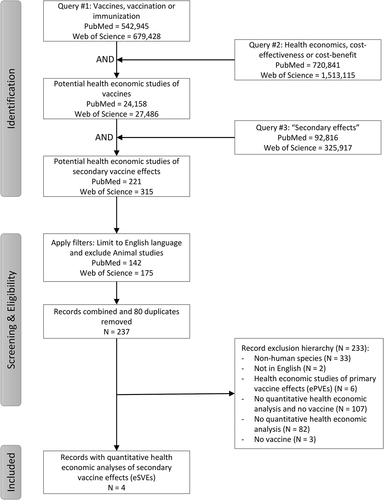Figures & data
Table 1. Definitions of some terms associated with different fields/domains and our definitions for terms related to defining economics of secondary vaccine effects
Figure 1. Schematic overview of the underlying mechanisms for primary and secondary vaccine effects. Primary vaccine effects (PVEs) are almost exclusively under the umbrella of the adaptive immunity. As shown in the right panel, these effects are mediated through antigen-dependent activation of naïve B and T cells, ultimately resulting in production of antibodies by mature plasma cells, as well as the development of CD4+ helper and CD8+ cytotoxic T cells. Memory B and T cells (not shown) expedite production of activated B and T cells during subsequent exposures to the same antigen. The immunological underpinnings of Secondary Vaccine Effects (SVEs) are not as well established, but emerging evidence points largely to activation and/or training of the antigen-independent innate immunity. Activation of the innate immunity (middle panel) is complex and involves multiple systems, cell types, and chemical signals, a review of which is beyond the scope of this manuscript. Most importantly, the emerging field of the trained immunity (left panel) is thought to be the reason behind the enhanced immune response to various pathogens observed after administration of a specific vaccine. Innate immune memory is best described for cells of the myeloid lineage, including the bone marrow progenitors, through epigenetic modifications, metabolic reprogramming and enhanced cytokine production, collectively giving the innate immune system a so-called ‘defensive’ posture against pathogens. A minor component of SVEs may also be mediated secondarily through the adaptive immune system because of antibody cross-reactivity or antigen-mimicry.

Figure 2. Search strategy, exclusions and eligibility criteria used to identify quantitative health economic analyses of secondary vaccine effects (eSVEs) through 1 November 2021.

Table 2. Detailed literature search strategy to retrieve records related to quantitative health economic evaluations of vaccine secondary effects
